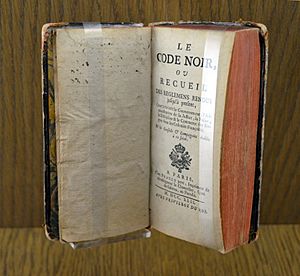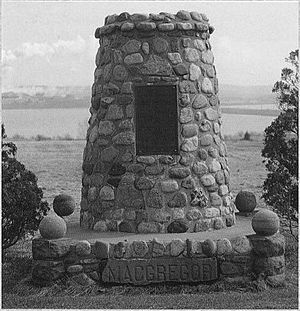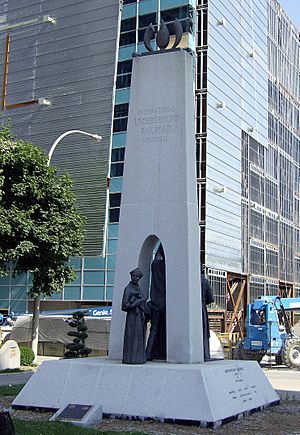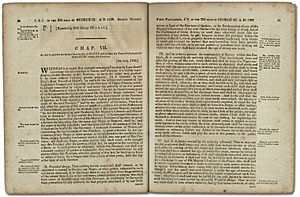Slavery in Canada facts for kids
Slavery in Canada means the time in history when people were forced to work without pay and treated as property. This happened both among some Indigenous groups long before Europeans arrived, and later when European settlers came to Canada.
Britain officially ended slavery in Canada and other British colonies in 1833 with the Slavery Abolition Act. However, slavery had mostly stopped in Canada even earlier, in the early 1800s. This happened because of local laws and court decisions. Courts in places like Lower Canada and Nova Scotia made it very hard for slave owners to keep people enslaved. For example, in Lower Canada, after court rulings in the late 1790s, enslaved people could leave their owners whenever they wanted. Upper Canada passed the Act Against Slavery in 1793, which was one of the first anti-slavery laws in the world.
Slavery continued in the United States until 1865. Because of this, many Black people, both free and enslaved, moved to Canada from the United States. This happened after the American Revolution and again after the War of 1812. Many came through a secret network called the Underground Railroad.
Canada's involvement in the Atlantic slave trade (where people were taken from Africa and sold as slaves) was smaller compared to other parts of the Americas. Because of this, the history of Black slavery in Canada is sometimes less known than the history of slavery elsewhere.
Contents
Slavery Among Indigenous Peoples
Some Indigenous groups in what is now Canada had a history of owning slaves. For example, fishing societies along the Pacific coast, from Alaska to California, sometimes had slaves. Groups like the Haida and Tlingit were known as strong warriors and slave-traders. They would even raid as far south as California.
Slavery was often passed down through families. Slaves were usually prisoners of war and their children were also considered slaves. In some parts of British Columbia, even as late as the 1970s, descendants of slaves were sometimes treated differently. Among a few Pacific Northwest nations, about a quarter of the population could be slaves.
One story of slavery was written by an Englishman named John R. Jewitt. His ship was captured in 1802 by the Nuu-chah-nulth people. This happened because the ship's captain had disrespected their chief, Maquinna. Jewitt's book gives a detailed look at what life was like as a slave.
Slavery Under European Rule
A historian named Marcel Trudel believes there were fewer than 4,200 slaves in the area of Canada (New France) and later the Canadas between 1671 and 1831. About two-thirds of these slaves were Indigenous people (around 2,700, often called panis). The other third were people of African descent (about 1,443). They mostly worked as house servants or farm workers.
The number of Black slaves grew when the British took over, especially after 1783 when United Empire Loyalists arrived. The The Maritimes (Nova Scotia, New Brunswick, and Prince Edward Island) saw 1,200 to 2,000 slaves arrive before slavery ended there. About 300 slaves arrived in Lower Canada and between 500 and 700 in Upper Canada. A small number of Black Canadians today are descendants of these enslaved people.
People of African descent were captured by local chiefs and sold to traders. These traders then took them to southern parts of the Americas. Slaves in what is now Canada usually came from the American colonies. No large ships full of slaves came directly to Canada from Africa. Canada did not have large farms (plantations) like other European colonies, so there was no need for a huge number of slaves.
French Rule and Enslaved People
Under French rule, there were more enslaved Indigenous people than enslaved people of African descent. According to historian Afua Cooper, it was easier for New France to get Indigenous slaves. She noted that many slaves died young. The average age of Indigenous slaves was only 17, and for slaves of African descent, it was 25. One of the first Black slaves recorded in Canada was brought by a British group to New France in 1628. His name was Olivier le Jeune, and he was originally from Madagascar.
By 1688, New France had about 11,562 people. Most were fur traders, missionaries, and farmers living in the St. Lawrence Valley. New France needed more workers. King Louis XIV allowed them to bring Black slaves from West Africa. However, no slave ships ever arrived directly from Africa. Colonists got some Black slaves from other French and British colonies. From the late 1600s, they also got Indigenous slaves, mostly from what is now the U.S. Midwest. These slaves were often captives from wars, taken by Indigenous allies and trading partners of the French. These Indigenous slaves were called "Panis," but few were actually from the Pawnee tribe. More often, they were from the Fox, Dakota, Iowa, and Apache groups.

Slavery was not allowed in France itself, but it was permitted in its colonies. This was to provide a large workforce to clear land, build, and work on farms (especially sugar, indigo, and tobacco farms in the Caribbean). The 1685 Code Noir (Black Code) set rules for slavery in the West Indies. It said that all slaves must be taught as Catholics. It also defined what slavery was and set up strict controls. Slaves had almost no rights, though the Code did tell masters to care for the sick and old. The Code Noir did not seem to apply to Canada. So, in 1709, an official named Jacques Raudot issued an order officially recognizing slavery in New France. Slavery existed before this date, but it became law in 1709.
One enslaved woman is well-known in Montreal's history: Marie-Joseph Angélique. She was enslaved by a rich widow in the city. In 1734, Angélique learned she was going to be sold and separated from her loved one. She set fire to her owner's house and ran away. The fire spread and destroyed 46 buildings. Angélique was caught two months later. She was forced to confess her crime. On the day she was to be executed, Angélique was taken through the streets of Montreal. She was then hanged until she died. Her body was thrown into the fire, and her ashes were scattered.
Historian Marcel Trudel recorded about 4,000 slaves by the end of French rule in 1759. Of these, 2,472 were Indigenous people, and 1,132 were Black. After the British took over New France, French people still owned most of the slaves. Trudel found 1,509 slave owners, and only 181 of them were English. Trudel also noted that 31 marriages happened between French colonists and Indigenous slaves.
British Rule and Slavery
Indigenous groups continued to own or trade slaves, a practice that had existed for hundreds of years among some groups. Tribes like the Shawnee and Potawatomi brought slaves from Ohio and Kentucky. They sold or gave these slaves to their allies and to Canadian settlers. Mohawk Chief Thayendenaga (Joseph Brant) used Black people he had captured during the American Revolution to build his homes. Brant owned about 40 Black slaves in total.
Black slaves lived in British Canada in the 1700s. A 1767 count in Nova Scotia listed 104 slaves. But their numbers were small until the United Empire Loyalists arrived after 1783. When white Loyalists left the new American Republic, they brought about 2,000 Black slaves with them. About 1,200 went to the Maritimes, 300 to Lower Canada, and 500 to Upper Canada. In Ontario, a law in 1790 promised new immigrants that their slaves would remain their property. Like under French rule, Loyalist slaves were few in number. They worked as house servants, farm workers, and skilled craftspeople.
After the Battle of the Plains of Abraham and the British takeover of New France, slavery in Canada was not mentioned in the peace treaties. It was neither banned nor allowed in the Treaty of Paris of 1763, the Quebec Act of 1774, or the Treaty of Paris of 1783.
The harsh system of gang labor, common in the USA, did not develop in Canada. Slaves were allowed to learn to read and write, and their Christian conversion was encouraged. Their marriages were also recognized by law. However, many slaves still died young, showing that slavery was still a very cruel system.
Ending Slavery in Canada
Lower Canada (Quebec)
In Lower Canada, Chief Justice Sir James Monk made several important decisions in the late 1790s. These decisions made it very hard for slave owners to force their slaves to work. While he did not officially end slavery, he made it almost impossible to enforce. He said that slavery was "unsupported in law." He then "systematically dismissed all suits by owners against runaway slaves." This meant that enslaved people could leave their masters whenever they wanted.
Even though people asked the government to make laws to protect slave owners' rights, there was not enough support to either fully end slavery or fully enforce it. Because Lower Canada did not pass any laws on the matter, it became impossible to send runaway slaves back to their owners. This made Canada a safe place for enslaved people seeking freedom. As a result, slaves began to escape from their owners within the province, and also from other provinces and the United States. This happened several years before Upper Canada passed its law to limit slavery.
In 1829, the leader of Lower Canada, Sir James Kempt, refused a request from the U.S. government to return an escaped slave. He explained that runaway slaves could only be returned if their crime was also a crime in Lower Canada. He stated, "The state of slavery is not recognized by the Law of Canada. ... Every Slave therefore who comes into the Province is immediately free."
Nova Scotia's Role in Abolition

Many Black people who came to Nova Scotia during the American Revolution were free, but others were not. Some Black people arrived in Nova Scotia as property of white American Loyalists. In 1772, Britain outlawed the slave trade in the British Isles. This decision, along with a similar one in Scotland in 1778, influenced Nova Scotia.
In 1788, an abolitionist named James Drummond MacGregor from Pictou published the first anti-slavery writing in Canada. He began buying slaves' freedom and criticized church leaders who owned slaves. Historian Alan Wilson called his document "a landmark on the road to personal freedom."
Two chief justices, Thomas Andrew Lumisden Strange (1790–1796) and Sampson Salter Blowers (1797–1832), were very important in freeing slaves from their owners in Nova Scotia. Justice Alexander Croke (1801–1815) also seized American slave ships during this time. By the end of the War of 1812, there were few slaves left in Nova Scotia. The Slave Trade Act outlawed the slave trade in the British Empire in 1807. The Slavery Abolition Act of 1833 finally outlawed slavery completely.
The Sierra Leone Company was created to move groups of formerly enslaved Africans. Nearly 1,200 Black Nova Scotians, most of whom had escaped slavery in the United States, moved to Freetown in Sierra Leone in 1792. This settlement became the first safe place in Africa for formerly enslaved Africans.
Upper Canada (Ontario) and the Act Against Slavery
By 1790, the movement to end slavery was growing in Canada. An event in 1793 showed how cruel slavery was. A slave woman named Chloe Cooley was being violently abused by her owner while being taken to be sold in the United States. She screamed and resisted. This abuse was seen by Peter Martin and William Grisely. Peter Martin, who was formerly enslaved, told Lieutenant Governor John Graves Simcoe about the incident.
Because of Simcoe's efforts, the Act Against Slavery was passed in 1793. Many elected officials, who were merchants or farmers and relied on slave labor, did not want to end slavery. Attorney-General John White later wrote that there was "much opposition but little argument" against his proposal. Finally, the Assembly passed the Act Against Slavery, which slowly ended slavery. It said:
- No new slaves could be brought into Upper Canada.
- Slaves already in the province would remain enslaved until they died.
- Children born to enslaved women would be slaves but had to be freed at age 25.
To discourage owners from freeing their slaves, the Act required masters to promise that the freed person would not become a burden on the public. This law ensured that slavery would eventually end in Upper Canada. However, it also meant that slaves became less valuable in the province, leading some to be sold to the United States. In 1798, some groups tried to change the law to allow more slaves to be imported. Enslaved people learned they could gain freedom by escaping to Ohio and Michigan in the United States.
By 1800, other British North American provinces had also limited slavery through court decisions. These decisions required very strict proof of ownership, which was rarely available. In 1819, John Robinson, the Attorney General of Upper Canada, declared that by living in Canada, Black residents were free. He also said that Canadian courts would protect their freedom.
Slavery remained legal, however, until the British Parliament's Slavery Abolition Act finally ended slavery in most parts of the British Empire on August 1, 1834.
The Underground Railroad

In the early to mid-1800s, the Underground Railroad was a secret network in the United States. Its goal was to help enslaved people escape to places where they would be free. British North America, now known as Canada, was a major destination for the Underground Railroad. Many Canadian children learn about slavery mostly through the story of the Underground Railroad.
In Nova Scotia, a formerly enslaved man named Richard Preston started the African Abolition Society. He fought to end slavery in America. Preston trained as a minister in England and met many important leaders in the abolitionist movement. These leaders helped pass the Slavery Abolition Act in 1833. When Preston returned to Nova Scotia, he became the president of the Abolitionist movement in Halifax.
There are cemeteries for enslaved people in parts of Canada. Some are not well-maintained. These include cemeteries in St-Armand, Quebec; Shelburne, Nova Scotia; and Priceville and Dresden in Ontario.
See also
- Marie-Joseph Angélique
- Marguerite Duplessis
- Sophia Pooley
- History of slavery
- Human rights in Canada
- History of slavery in Louisiana
- Turner Chapel, Oakville's Black church
- R v Jones (New Brunswick)


